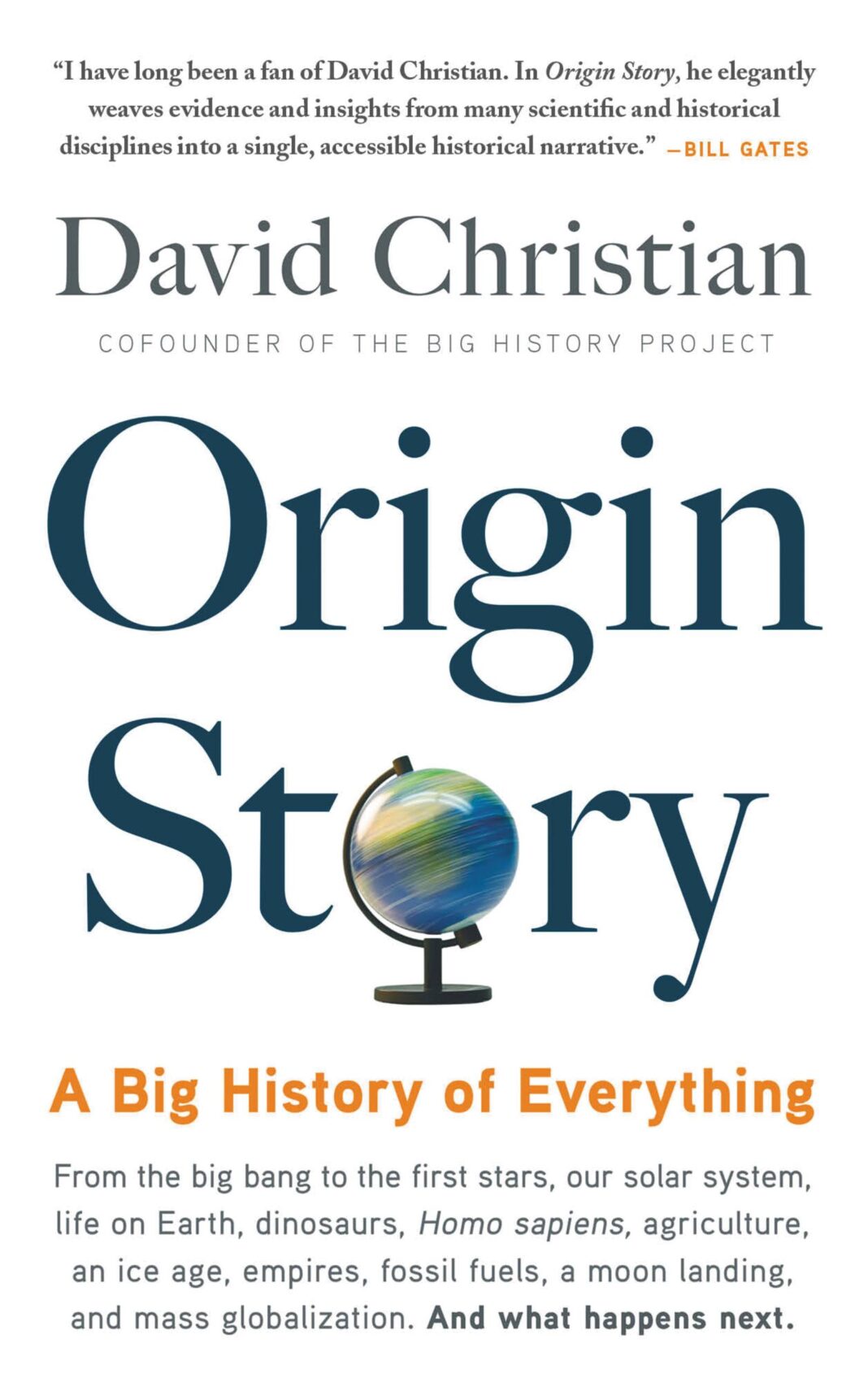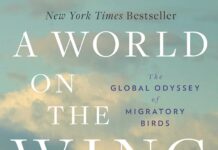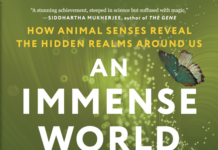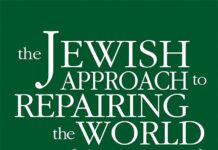What makes humans different from all other brainy species is language, a communication tool that is extraordinarily powerful because it allows us to share our individual world maps and, in so doing, form maps much larger and more detailed than those created by an individual brain.
“What’s the meaning of the universe?” asked Joseph Campbell, a scholar of myth and religion. “What’s the meaning of a flea? It’s just there, that’s it, and your own meaning is that you’re there.”
French philosopher Blaise Pascal wrote: “Knowledge is like a sphere; the greater its volume, the larger its contact with the unknown.”
Frankly, today we have no better answers to the problem of ultimate beginnings than any earlier human society had. Bootstrapping a universe still looks like a logical and metaphysical paradox. We don’t know what Goldilocks conditions allowed a universe to emerge, and we still can’t explain it any better than novelist Terry Pratchett did when he wrote, “The current state of knowledge can be summarized thus: In the beginning, there was nothing, which exploded.”
Within a billionth of a billionth of a billionth of a billionth of a second after the big bang, energy itself underwent a phase change. It split into four very different species. Today, we know them as gravity, the electromagnetic force, and the strong and weak nuclear forces.
Until just over a century ago, scientists and philosophers assumed that matter and energy were distinct. We now know that matter is really a highly compressed form of energy.
The first law of thermodynamics tells us that the ocean of energy is always there; it’s conserved. The second law of thermodynamics tells us that all the forms that emerge will eventually dissolve back into the ocean of energy. The forms, like the movements of a dance, are not conserved.
The second law of thermodynamics tells us that, in the very long run, all free energy will turn into heat energy. Heat energy, like a drunken traffic cop, directs energy every which way and creates chaos. Free energy, like a sober traffic cop, directs energy down particular routes and creates order.
The idea of a complexity tax helps explain an important phenomenon noted by the astrophysicist Eric Chaisson: roughly speaking, more complex phenomena need more dense flows of energy, more energy per gram per second. He estimates, for example, that the density of energy flowing through modern human society is about one million times greater than the density of energy flowing through the sun, while energy flowing through most living organisms lies somewhere between these extremes. It’s as if entropy demands more energy from an entity if it tries to get more complex; more complex things have to find and manage larger and more elaborate flows of free energy. No wonder it’s harder to make and maintain more complex things, and no wonder they usually break down faster than simpler things. This is an idea that runs right through the modern origin story and has a lot to tell us about modern human societies.
Increasing complexity is not a triumph over entropy. Paradoxically, the flows of energy that sustain complex things (including you and me) are helping entropy with its bleak task of slowly breaking down all forms of order and structure.
Our solar system lies in the galaxy we call the Milky Way in a stellar suburb on one of the Milky Way’s spiral arms, the Orion spur. The Milky Way is one member of a group of about fifty galaxies, known, unromantically, as the Local Group. The Local Group lies in the outer regions of the Virgo Cluster, which has about a thousand galaxies. This is part of the Local Supercluster, which includes hundreds of groups of galaxies. It would take you one hundred million years traveling at the speed of light to cross it. In 2014, it was found that the Local Supercluster is part of a vast cosmic empire with perhaps a hundred thousand galaxies, and to cross that would take you four hundred million years traveling at the speed of light. This empire is the Laniakea (Hawaiian for “immeasurable heaven”) Supercluster. At present, this is the largest structured entity we know of in the universe. We assume that Laniakea is built around a scaffolding of dark matter whose gravitational pull holds all these galaxies together as the universe expands
The average human takes in about 2,500 calories each day, about 10.5 million joules (a measure of work or energy; a calorie represents about 4,184 joules). Divide this by the 86,400 seconds in a day, and an individual mobilizes about 120 joules every second. This is the “power rating” of a human being: 120 watts, just slightly greater than the power rating of many traditional lightbulbs.
In its most general form, information consists of rules that affect outcomes by limiting possibilities. One of the most famous definitions of information is “a difference which makes a difference.”
Information in this very general sense limits what is possible, so it reduces randomness. This is why more information seems to mean less entropy, less potential for the disorder that entropy loves.
Indeed, some have argued that entropy actually likes the idea of life (and may encourage it to appear in many parts of the universe), because life degrades free energy so much more efficiently than nonlife.
Life appeared early in the history of planet Earth, and that suggests that creating simple forms of life may not be too hard where the right Goldilocks conditions exist.
At present, the best direct evidence for the earliest life on Earth consists of microscopic fossils found in Western Australia’s remote Pilbara region in 2012. They seem to be of bacteria that lived about 3.4 billion years ago.15 In September 2016, an article in Nature described 3.7-billion-year-old fossils of what looked like coral-like stromatolites that were found in Greenland.16 If these are what many think they are, life must have begun evolving millions of years earlier than previously believed and must have appeared soon after the end of the Late Heavy Bombardment, about 3.8 billion years ago.
Though they don’t know exactly what it looked like, biologists refer to the first living organism as Luca (or LUCA, from “last universal common ancestor”). Luca certainly lived earlier than the earliest life-forms we have discovered so far, and it shared many features with the modern organisms known as prokaryotes: single-celled organisms whose genetic material is not protected within a nucleus
Luca might have been sort of alive but not fully, somewhere in the zombie zone between life and nonlife. This is not as evasive an idea as it might seem. Viruses are not fully alive because they don’t tick all the boxes in our definition of life. They have no metabolism, and they have extremely fragile membranes, so it’s not even clear that we can describe them as cells. They are little more than packets of genetic material that glom on to more complex organisms. They enter another cell, hijack the cell’s metabolic mechanisms, and use it to make copies of themselves. When you have the flu, viruses are siphoning energy from your metabolic pipelines. But when they can’t find cells to hijack, viruses shut down and lurk in a sort of suspended animation.
Composite sketches of Luca have been built up by identifying several hundred genes that are present in most modern prokaryotes and are probably extremely ancient.
The composite Luca (or family of Lucas, because we’re really talking about billions of them) could adjust to changes in its environment. It had a genome, so it could reproduce. And it evolved. Luca may have lacked both its own membrane and its own metabolism. Its cell walls were probably made of porous volcanic rock, and its metabolism depended on geochemical flows of energy over which it had little control. The proteins Luca made suggest that it lived at the edge of alkaline oceanic vents, probably inside tiny pores in lavalike rocks, and it got its energy from nearby gradients of heat, acidity, and flows of protons and electrons. Luca’s chemical innards probably sloshed around in warm liquids from inside the Earth that were alkaline, which meant they had an excess of electrons. Just outside the volcanic pores Luca called home were cooler ocean waters that were more acidic, which meant they had an excess of protons. Like a charged battery, the tiny electrical gradient between Luca’s insides and the outer world provided the free energy needed to drive its metabolism, draw in nutrients from outside, and expel waste materials.
She [Luca] was not a free-living cell but a rocky labyrinth of mineral cells, lined with catalytic walls composed of iron, sulphur and nickel, and energised by natural proton gradients. The first life was a porous rock that generated complex molecules and energy, right up to the formation of proteins and DNA itself.
Enzymes cruise through the molecular sludge, looking for target molecules that they fit on to, the way a wrench fits a particular nut or bolt. Then the enzyme uses tiny shots of energy to tap, bend, crack, or split the molecule, or bind it to other molecules. Most reactions in your body could not happen without enzymes or would require activation energies so high they would damage the cell. Once the enzyme has knocked its target molecule into shape, it breaks away and goes hunting for other molecules that it can bend to its will. Enzymes can also be switched on or off by other molecules that bind to them and slightly alter their shape, and this is how, like billions of transistors in a computer, enzymes govern the fantastically complex reactions that go on inside cells.
Energy is carried to enzymes and other parts of the cell by molecules of ATP, or adenosine triphosphate, and ATP was probably hard at work already inside Luca. Enzymes and other molecules tap ATP’s energy by breaking off a small group of atoms, releasing the energy that binds that group to the molecule. The depleted molecule (now called ADP, for adenosine diphosphate) then heads off to special generator molecules that recharge it by replacing the lost atoms. The generator molecules are powered by a remarkable process called chemiosmosis, which was discovered only in the 1960s but seems to have been at work since the time of Luca. Inside each cell, food molecules are broken down to capture the energy they contain, and some of that energy is used to pump individual protons from inside the cell (where there is a low concentration of protons) to outside the cell (where there is a high concentration of protons). This is like charging a battery. It creates an electrical gradient between the outside and inside of the cell, with a voltage similar to what Luca may have used at alkaline vents. Special generator molecules (ATP synthase, for the technically minded) that are embedded in cell membranes use the electrical voltage created by protons returning from outside the membrane to drive nano-rotors. Like rotary assembly lines, the rotors charge up ADP molecules by replacing the group of molecules they have lost, then the charged-up ATP molecules go back into the cell and wait for other molecules to plug into them and get the energy they need to keep working.
This elegant cellular electrical grid is present in all cells today. It untethered cells from the energy flows around volcanic vents, allowing the earliest prokaryotes to roam Earth’s oceans, scrounging energy from food molecules and using them to create ATP molecules that could supply the energy needed to power the cell’s innards
Special enzymes expose stretches of DNA that correspond to a particular gene or code for a particular protein, and each base attracts its opposite to create a new short RNA chain of nucleotides that is complementary to the original chain. The newly created segment is then whisked off to a large molecule known as a ribosome, which is a sort of protein factory. The ribosome reads the sequence of letters in triplets and extrudes the corresponding amino acids, one by one, in just the right order to make a particular protein, which then goes off into the cell to do its work. In this way, ribosomes can manufacture all of the thousands of proteins a cell needs.
The final piece of magic is that DNA and RNA molecules can use these copying mechanisms to make copies of themselves and all the information they contain. The bases that stick out sideways from their sugar-phosphate chains reach into the cellular sludge and grab onto their complements. Thus, Cs always grab onto Gs, and As always grab Ts (or Us, in RNA). The newly attached bases attract new sugar molecules that link together, and in this way they form a new chain that is the exact complement of the first. In DNA, these two complementary chains normally stick together, which is why DNA usually exists in the form of a double chain or helix, like a pair of winding staircases. It can be wound up so tightly that it packs neatly inside each cell, and it is unwound only to be read or to make copies of itself. However, RNA normally exists as a single chain, so, like a protein, it can also fold up into particular shapes and function like an enzyme.
The impact of the first forests was particularly significant because as yet, there were no organisms that could break down the lignin in wood. That’s why forests from the Carboniferous period (from 360 to 300 million years ago) were mostly buried beneath the soil, along with the carbon they had drawn down from the atmosphere. Over time, they fossilized to form the coal seams that later powered the industrial revolution. About 90 percent of today’s coal deposits were buried during the period of high oxygen levels, from around 330 to 260 million years ago.
Emotions drive decision-making in all animals with large brains, and some emotions, like fear, are probably present in all vertebrates and maybe in some invertebrates, particularly the most intelligent ones such as the octopi.
Sensations, emotions, and thought together create the inner, subjective world that all humans, and probably many other large-brained species, experience. The state that we describe as consciousness seems to be a mode of sharply focused attention summoned by the brain, as if to a court of law, when new, difficult, and important decisions have to be made. That suggests that consciousness is present to some degree in many organisms whose brains are large enough to provide the necessary working space for really complex decision-making.19 But it is not needed for routine decisions.
The world of the dinosaurs vanished in just a few hours when a ten-to fifteen-kilometer-wide asteroid crashed into Earth. The crash caused a major extinction event, during which about half of all genera disappeared. Geologists refer to this as the K/T event because it occurred at the border between the Cretaceous period (often abbreviated K, from the German word for “chalk,” Kreide) and the Tertiary period, an older name for the Cenozoic era, which began sixty-five million years ago. When the asteroid hit, it was moving at thirty kilometers a second (about one hundred thousand kilometers an hour), having taken just seconds to fly through Earth’s atmosphere. We know exactly where it fell: in the Chicxulub (pronounced “Chikshulub”) crater in the Yucatán Peninsula of modern Mexico. The asteroid evaporated as it punched through the crust, leaving a crater almost two hundred kilometers across.
In the Hell Creek Formation, in Montana and Wyoming, you can find fossils of fish whose gills are full of glass from the asteroid impact.
Viewed ecologically, states and their rulers represent a new step in the food chain, a new trophic level. We have seen how energy from sunlight enters the biosphere through photosynthesis and travels from plants to herbivores to carnivores. And we have seen how most of that energy gets wasted at each trophic level, in a sort of garbage tax. That leaves much less energy to support the higher levels, which is why there are fewer lions than antelopes. Agriculture increased the resources available to humans, so states could add one more trophic level at the top of the hierarchy. Rulers and nobles and officials began to squeeze wealth from the labor and produce of peasants, who in turn got their energy and food from farming.
Thinking about such processes in ecological terms reminds us that wealth never really consists of things; it consists of control over the energy flows that make, move, mine, and transform things. Wealth is a sort of compressed sunlight, just as matter is really congealed energy.
Perhaps we can think of fossil fuels as the activation energy that was needed to kick-start today’s world. Now that this glossy new world is in motion, can we keep it going with smaller and more delicate energy flows, like the tiny flows, electron by electron, or proton by proton, that are managed by enzymes and that energize living cells? Can we imitate respiration, big life’s delicate, nondisruptive equivalent of fire?
Perhaps the idea of endless growth is completely wrong. Perhaps the disruptive dynamism of recent centuries is a temporary phenomenon. After all, living life within a framework of social and cultural stability has been the norm for most of human history and for most human societies. And that is why an understanding of what it means to live richly and dynamically in a less changeable world is preserved within the cultures of many modern indigenous communities whose people see themselves primarily as custodians of a world larger and older than themselves.
At present, it looks as if continental plates will regather in a new supercontinent that has already been dubbed Amasia because it will join Asia and the Americas.




